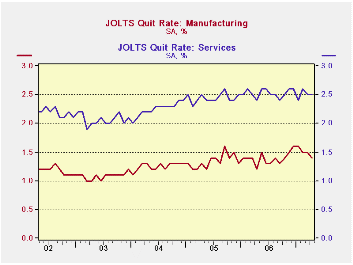 Global| Jun 12 2007
Global| Jun 12 2007JOLTS Headlines Weaker Than Report Itself Seems…
Summary
The JOLTS report quit rate is the most important reading of this varied report that has regional and industry detail as well as national readings. When people are wiling to QUIT the jobs they have it is the best sign of strength in [...]

The JOLTS report quit rate is the most important reading of this varied report that has regional and industry detail as well as national readings. When people are wiling to QUIT the jobs they have it is the best sign of strength in the underlying labor market. This month the private quit rate remained steady at 2.2% while the quit rate in services industries remained high (79.8 percentile of its range) and the MFG sector saw quits drop to 1.4% from 1.5% in what has been a sector with weakening labor demands. The quit rate rose – surprisingly in construction but the seasonal construction work is beginning to pick up at this time of year. And the government quit rate, while a scant 0.7%, is as high as it has ever been – government workers simply don’t quit; many have the job for its job security and pension.
Sector Detail – complied from report details (see table)-- Services and Government showed a high quit rate in April and, while the construction sector’s quit rate rose in the month, it was still in the bottom 20Th percentile of its range. Hires were very strong for government - at the top of its range. This reading squares with recent reports that tell us that many states have seen revenues rise above their expectations. Hires are also firm in services: approximately in the top third of its range. The job openings readings are strong in their respective ranges across industries, save construction, but that reading is not matched by strength in hires everywhere. Either this is an example of worker skill shortages or job openings statistics are vague and substantially meaningless. Separations are in the top two-thirds of their range for services and MFG and they are stronger still in Government. They remain low in construction. In MFG it is probably early retirements at work or negotiated attrition since layoffs per se were not up on the month.
On balance, the JOLTS report confirms the positive trends we have seen in MFG, Services and the weakness in construction. The Government sector appears to have become a stronger source of job creation and employee retention. The private quit rate is stable and strong and is well underpinned by the service sector. Weakness in MFG jobs does not seem a threat to overall labor market strength. On balance, the detail of this report is encouraging about the economy.
| As of…… | Major Job Sectors | |||
| Apr-07 | Services | MFG | Construction | Gov't |
| Job Openings | 76.2% | 84.6% | 57.1% | 87.5% |
| Hires | 65.1% | 42.9% | 13.3% | 100.0% |
| Separations | 62.9% | 66.7% | 29.2% | 75.0% |
| Quits | 79.8% | 66.7% | 16.7% | 100.0% |
| Raw readings by Industry | ||||
| OPENINGS | Services | MFG | Construction | Gov't |
| Apr-07 | 2.5 | 2.3 | 2.0 | 2.1 |
| Mar-07 | 2.3 | 2.2 | 1.9 | 2.1 |
| Feb-07 | 2.6 | 2.3 | 2.9 | 2.1 |
| Jan-07 | 2.6 | 2.3 | 1.8 | 2.1 |
| Hires | Services | MFG | Construction | Gov't |
| Apr-07 | 4.4 | 2.5 | 4.3 | 1.9 |
| Mar-07 | 4.3 | 2.3 | 4.6 | 1.8 |
| Feb-07 | 4.5 | 2.6 | 3.9 | 1.7 |
| Jan-07 | 4.5 | 2.6 | 3.9 | 1.7 |
| SEPARATIONS | Services | MFG | Construction | Gov't |
| Apr-07 | 4.0 | 2.8 | 4.9 | 1.4 |
| Mar-07 | 4.1 | 2.8 | 4.5 | 1.4 |
| Feb-07 | 4.0 | 3.0 | 4.2 | 1.3 |
| Jan-07 | 4.0 | 2.8 | 5.2 | 1.4 |
| QUITS | Services | MFG | Construction | Gov't |
| Apr-07 | 2.5 | 1.4 | 1.8 | 0.7 |
| Mar-07 | 2.5 | 1.5 | 1.7 | 0.7 |
| Feb-07 | 2.6 | 1.5 | 1.6 | 0.6 |
| Since 2000 | ||||
Robert Brusca
AuthorMore in Author Profile »Robert A. Brusca is Chief Economist of Fact and Opinion Economics, a consulting firm he founded in Manhattan. He has been an economist on Wall Street for over 25 years. He has visited central banking and large institutional clients in over 30 countries in his career as an economist. Mr. Brusca was a Divisional Research Chief at the Federal Reserve Bank of NY (Chief of the International Financial markets Division), a Fed Watcher at Irving Trust and Chief Economist at Nikko Securities International. He is widely quoted and appears in various media. Mr. Brusca holds an MA and Ph.D. in economics from Michigan State University and a BA in Economics from the University of Michigan. His research pursues his strong interests in non aligned policy economics as well as international economics. FAO Economics’ research targets investors to assist them in making better investment decisions in stocks, bonds and in a variety of international assets. The company does not manage money and has no conflicts in giving economic advice.






